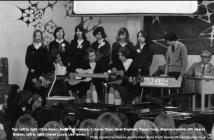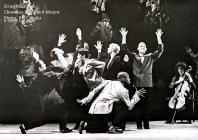Content can be downloaded for non-commercial purposes, such as for personal use or in educational resources.
For commercial purposes please contact the copyright holder directly.
Read more about the The Creative Archive Licence.
Description
This photograph shows a small fragment of transfer printed earthenware. This was an extremely popular style of pottery during the 18th and 19th century and still continues to be produced to this day, in fact you yourself may have a transfer printed tea set at home. This type of pottery was a common produce of British potteries from the mid 18th century onwards (Woods 2012). This style of pottery cannot be attributed to one entrepreneur, but rather to the pottery industry as a whole as many potters and factories experimented with printing techniques to produce a wide range of decorative patterns (Copeland 2000). Many transfer printed wares employed a variety of coloured ink depending on the potter, the most common being black or cobalt blue and depicted a variety of engraved scenes such as ships, ruined abbeys and castles and famous heroes of the period like General Cornwallis, usually accompanied with descriptions or poems (ibid). The scenes changed as tastes and fashions developed, the most popular being oriental willow pattern (the scenes themselves where invented by the potters to improve sales and had no relation to Chinese myths and legends), usually depicting a typical scene of trees, water, bridges, pagodas, birds and people, a design which is still popular today (Chang 2010).
The pattern depicted on the fragment in the photograph is likely to be associated with an oriental scene. The pattern itself first appeared in the late 18th century and was inspired by the Chinese porcelain (china) that Britain was importing in bulk from China (Copeland 2000). Between 1789 - 1793 Josiah Spode (1733 – 1797) perfected his technique of producing bone china meaning the demand for porcelain could be met within Britain rather than importing it from China (Copeland 2000). Before this period the most common fabric that was used was earthenware, an example of which is the fragment in the photograph (Woods 2012). It is therefore likely that this fragment of pottery dates from the mid 18th to early 19th century. From looking at the shape and profile and thickness of this fragment it is likely that this would have once belonged to a plate (Woods 2012).
Chang, E. 2010 Britain’s Chinese Eye: Literature, Empire, and Asthetics in Nineteenth-Century Britain. Stanford University Press.
Copeland, R. 2000 Blue & White Transfer-Printed Pottery. Oxford: Osprey publishing.
Woods, M. 2012 The National Botanic Garden of Wales: A History Through Finds. University of Wales, Trinity Saint David. Unpublished






Do you have information to add to this item? Please leave a comment
Comments (0)
You must be logged in to leave a comment